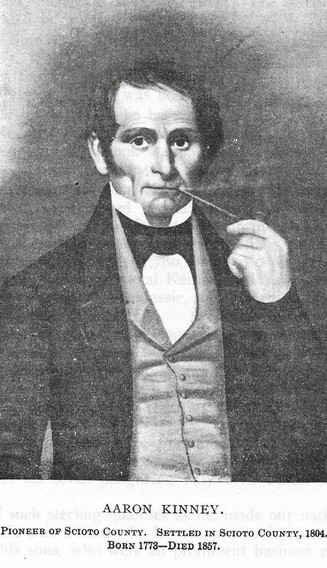The Kinney-Briggs Cemetery
Introduction
Text-to-speech Audio
Images
Image of Aaron Kinney (1773-1857)

Backstory and Context
Text-to-speech Audio
The Kinney family originally came to Portsmouth, Ohio from Pennsylvania in the year 1804. Aaron Kinney and his wife Mary were both wealthy landowners, who ended up giving birth thirteen children, twelve of which lived into adulthood. These twelve children went on to become key leaders and citizens within the Portsmouth Community, becoming local government officials, bankers, businessmen, and river transportation workers. The Kinney family was so influential in Portsmouth's development, that a central road was named in their honor.
In addition to their cemetery, the original Kinney Homestead that was home to Aaron and Mary Kinney has been converted into a museum that preserves the history of Southern Ohio known as the 1810 House. That homestead is located just down the road from the cemetery. On a deed dated October 18, 1839, Aaron and Mary gave the land that would later become the Kinney-Briggs Cemetery to their three sons Washington, Eli, and Peter before passing almost 10 years later. At the time the land cost only $1.00, which would be equal to about $30.00 today.
Other influential members of Portsmouth's Community are also buried within the Kinney Family's Cemetery. One such individual is Major Uriah Barber. Born on January 2, 1761, Uriah Barber fought in the revolutionary war on the side of the patriots and achieved high ranks. He landed on the Little Scioto River in 1796, and is credited to have built the first log cabin in Portsmouth. This cabin later became the Old National hotel in 1803. After the war, Major Uriah Barber settled down in Portsmouth and was the earliest County Coroner in the city's records. He died June 26, 1846 after the city received a surprise attack from the Scioto Tribe of Native Americans.Other veterans buried in the cemetery include John Clingman, who fought alongside Barber in the Revolutionary War, as well as Henry Hall and Samuel Ross who fought in the Mexican-American war. Respectively, their families including their wives and children, have also been buried at the Kinney-Briggs Cemetery.
Despite the significance of this burial ground to the history of Portsmouth, the cemetery spent years unmaintained and and after over a century, the Kinney-Briggs cemetery was completely overgrown and disappeared from the historic memory of the city. However, in 1991 a group of local neighborhood children discovered the gravestones when they were playing in the woods. "We noticed a tree had fallen down, and as we were playing on it we saw that it had landed on a brick wall," recounted Erin Isaac, one of those children, "My brothers Matt, Adam, and I went through and investigated, finding overturned gravestones. The entire cemetery was completely overgrown. Our summer project became cleaning up that cemetery, and trying to find out someone who could help us."
The family members helped to clear and clean up the cemetery to the best of their ability, and years later the local Historical Society was able to take over and maintain the grounds.The cemetery remains in need of restoration, and some of the tombstones are completely illegible after spending one hundred years neglected.
Sources
Eli. “WPA Project Locates Local Veterans' Graves.” Wandering Appalachia, 15 Feb. 2020, wanderingappalachia.org/2020/02/15/wpa-project-locates-local-veterans-graves/.
“Memorials in Kinney-Briggs Cemetery.” Find a Grave, www.findagrave.com/cemetery/41713/memorial-search?page=1#sr-43669294.
Portsmouth Daily Times. “Pioneer Burying Grounds – Old Kinney Cemetery.” Portsmouth Daily Times, 20 Oct. 2018, www.portsmouth-dailytimes.com/opinion/columns/32267/pioneer-burying-grounds-old-kinney-cemetery.
“PORTSMOUTH, OHIO.” 1810 House Portsmouth Ohio, www.1810house.org/history/history-of-the-kinney-family/.
Photo source: Find a Grave
